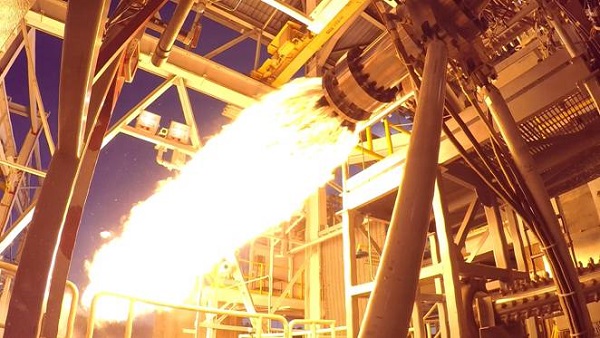For rockets, there exists a wide variety of fuels to choose from each having its ups and downs. So, while designing a rocket or, rocket engine to be specific, propellant/fuel selection is a very important factor to be considered since there are some parameters the fuel has to satisfy to be used as a potential fuel for spaceflights.
Conventional rocket fuels are classified into three. We are stressing on the word 'conventional' since there are some fuels or propellants which not so common in launch vehicles. We'll get to it in a while. So, the classification is as follows:
- Solid Propellants
- Liquid Propellants
- Hybrid Propellants
We will no look into the specifics of each of these propellant families.
SOLID PROPELLANTS
As the name suggests, these are propellants which are in solid phase. These propellants have a long history and go back to the 13th century when gunpowder was used as the propellant for war-rockets. Even after liquid rocket engines' popularity rose among space agencies, solid propellants are preferred for its good characteristics.
 |
| Cutaway view of a Solid Rocket motor, Credit: Purdue University |
In all combustion processes, three basic components are needed. Fuel, Oxygen and Heat. In solid propellant, fuel and oxidizer (the compound which provides the oxygen) is pre-mixed together before filling it into the rocket motor. For solid propellant based rocket stages, it is named as 'solid motors' rather than engines. For liquid propellant stages, 'engines' is used and not 'motor'.
The interesting fact is that the early stages of modern rocketry relied on liquid fuels rather than solid fuels. Werner von Braun's V-2, the earliest example of a proven rocket ran on a mixture of ethanol - water mixture (75% : 25%) as fuel and liquid oxygen (LOX) as the oxidizer. Tracing even back, the historic rocket made by Robert H. Goddard, which he launched on March 16, 1926, was fueled by gasoline and liquid oxygen as the oxidizer. This must be read along with the fact that Goddard studied about solid propellants too but chose to go with liquid fuels.
 |
| A V-2 missile being filled with LOX, Credits in pic |
It was during the final years of World War 2 did scientists started looking into solid propellants. The war was dragging on for too long and nations had to find a way to end it as soon as possible to prevent taking in too many losses. Back then, missiles were at its infancy and the most dreaded were the V-1 and V-2 by the Nazi Germany. However, due to the high cost, complexity of manufacturing liquid engines, scientists turned towards solid fuels for missiles. Solid based rockets which were used to attack enemy forces were in use then but they were too small to be considered as missiles.
ADVANTAGES OF SOLID PROPELLANTS
These are major advantages of solid propellants which makes it a go-to solution for simple rocket designs.
- Very simple construction: Manufacturing of solid rocket motors is extremely simple. Apart from few of the valves and minor other actuation mechanisms for the nozzle, there are no other moving parts in a solid motor. This helps agencies to reduce cost considerably and have a high launch frequency.

A segment of Space Shuttle Rocket Booster, Credit: NASA - Higher reliability: Due to the above mentioned simplicity, there is less chance of any mishaps happening with the motor. Liquid engines requires precision engineering and there is a higher chance of mishaps associated with it than solid motors.
- Easier storage: Solid fuels are easier to store compared to liquid fuels and also have higher storage life. This makes it an ideal fuel for missiles which spends most of its time in missile depots. Even after a long shelf period, the ignition characteristics of the fuel is not affected that much which adds on to this point.

Nike Hercules (MIM-14) Surface-to-Air missiles in storage
Credits in pic - High propellant density: Solid propellants have higher mass density than other forms of fuels, which means that they can be compacted to produce very high propellant density figures. Solid motors are known for producing a huge initial thrust, however they are low on specific impulse.
- Huge thrust: Solid rocket motors can produce an enormous amount of thrust. The largest solid rocket motors are the SRBs (Space Shuttle Solid Rocket Boosters) which at its peak could produce a maximum of 14.7 Mega Newtons of thrust! That's twice the thrust produced by the most powerful rocket engine ever flown - the mighty F1 of Saturn V.
Due to this, solid rocket motors are heavily employed for lower stages of rocket launch vehicles, since getting out of Earth's atmosphere is the most energy intensive part of a rocket launch.
Static test firing of SRB, 1978, Credit: NASA - Easy ignition: Solid motors can be ignited very easily and once it has been lit, it burn unti completion.
Even then, Solid propellants comes with its set of disadvantages too.
DISADVANTAGES OF SOLID PROPELLANTS
- Low specific impulse: Specific Impulse is a factor used in rocketry to determine how efficient is a rocket engine. It says how much fuel is consumed for producing a required amount of thrust. So, higher the specific impulse value higher would be the thrust produced per unit mass of propellant. Solid propellants fare quite bad in this than other fuels. They take up too much fuel to produce a fixed quantity of thrust.
- Sensitive to temperature effects: Solid propellants are cast into the rocket motor. When they are put in storage, low temperature could create cracks in the cast which is not desirable.
- No thrust modulation: This is easily the biggest criticism solid rocket motors have. Once the motor has been lit, there is absolutely no way of stopping the combustion process or modulating the thrust. Hybrid propellants were developed for countering this aspect. In case of any emergency there is no way of cutting the burning and this could be fatal in case of crewed missions.
Some sources may say that thrust vectoring is not possible in solid motors which is not true. It is possible to vector the thrust using gimbaled nozzles and guide vanes placed in exhaust's path. - Toxicity of gases: The exhaust gases produced by most solid propellants are highly toxic and some are even cancerous. This poses a huge health concern on the use of solid propellants and precaution is necessary while handling these.
That's all for this week, and we'll look more into Solid Propellant rockets in the next chapter. Cheerio!







0 Comments